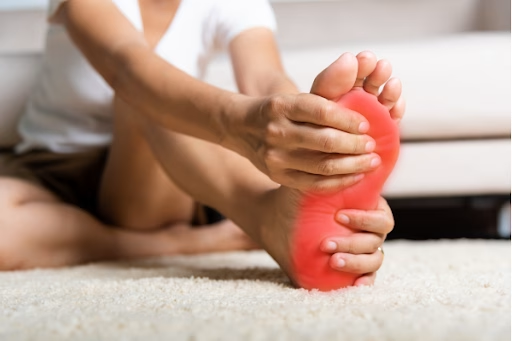
Injuries are an unavoidable part of life, whether you're an athlete, a weekend warrior, or simply walking down the stairs. When pain strikes after a fall or awkward movement, knowing whether you're dealing with a sprain or a fracture can be difficult. While the symptoms may seem similar at first—swelling, bruising, and limited mobility—the underlying damage and treatment requirements are often quite different.
At AFC Urgent Care Massachusetts, we evaluate and treat musculoskeletal injuries. Our medical professionals can accurately determine whether an injury is a sprain or fracture using on-site X-rays, physical exams, and clinical expertise. This blog will discuss the key differences, symptoms, causes, and when to seek medical help.
What Is a Sprain?
A sprain occurs when the ligaments, the tough, fibrous tissues that connect bones to other bones, are stretched or torn. Sprains most commonly occur in the ankles, knees, wrists, and fingers, typically after an awkward twist or fall.
Common Causes of Sprains:
- Rolling an ankle while walking or running
- Falling on an outstretched hand
- Sudden changes in direction during sports
- Missing a step or misjudging uneven ground
Symptoms of a Sprain:
- Pain around a joint
- Swelling and tenderness
- Bruising or discoloration
- Limited ability to move the joint
- A "popping" sound or feeling at the time of injury
Sprains range in severity:
- Grade I (Mild): Slight stretching and microscopic tearing
- Grade II (Moderate): Partial tearing of the ligament
- Grade III (Severe): Complete tear or rupture of the ligament
What Is a Fracture?
A fracture is a break, crack, or shattering of a bone, ranging from a thin hairline crack to a complete break that pierces the skin (compound fracture). Unlike sprains, fractures involve damage to the bone itself, which may require immobilization, casting, or surgical intervention.
Common Causes of Fractures:
- Direct trauma (e.g., falling, car accidents, sports injuries)
- Repetitive overuse (stress fractures)
- Conditions that weaken bones (osteoporosis, tumors)
Symptoms of a Fracture:
- Sharp, intense pain at the injury site
- Swelling and bruising that develop rapidly
- Inability to move the limb or joint
- Visible deformity or bone protrusion (in severe cases)
- Numbness or tingling (if nerves are affected)
- Pain that worsens with pressure or weight-bearing
Sprains vs. Fractures: Key Differences
| Feature | Sprain | Fracture |
|---|---|---|
| Affected Structure | Ligaments (connect bones to other bones) | Bones (the complex, structural parts of the body) |
| Pain Onset | May build gradually after the injury | Typically immediate and sharp |
| Mobility | Movement is possible, though limited | Movement is usually very limited or impossible |
| Swelling | Moderate, can increase over hours | Rapid and often more severe |
| Bruising | Ordinary develops near the joint | Very common, often extensive |
| Deformity | Rare, unless severe ligament damage | Possible, especially with displaced fractures |
| Popping Sound | Often occurs at the time of injury | Uncommon, may be accompanied by a crackling sound |
| Response to Pressure | Painful but somewhat tolerable | Severe pain with even light pressure |
While both conditions can cause significant pain and swelling, there are notable differences to be aware of.
Diagnosis: Why You Shouldn't Self-Diagnose
Because sprains and fractures can feel similar, self-diagnosing the injury at home can be risky. Misidentifying a fracture as a sprain can lead to improper healing, long-term damage, or worsening of the condition. That's why seeking professional evaluation after a moderate to severe injury is essential.
At AFC Urgent Care Massachusetts, we offer:
- On-site digital X-rays for immediate imaging
- Physical exams by experienced providers
- Same-day results and treatment plans
- Referrals for orthopedic follow-up or surgery, if needed
Treatment for Sprains
Mild to moderate sprains can often be managed conservatively using the R.I.C.E. method:
- Rest: Avoid activities that stress the injured area.
- Ice: Apply ice packs for 15–20 minutes every few hours to reduce swelling.
- Compression: Use an elastic bandage to provide support and limit swelling.
- Elevation: Keep the injured limb elevated above heart level to minimize swelling.
Your provider may also recommend:
- Over-the-counter pain relievers such as ibuprofen
- Temporary bracing or splinting
- Physical therapy for rehabilitation
Severe sprains (Grade III) may require immobilization and occasionally surgical repair if the ligament is completely torn.
Treatment for Fractures
Treatment for fractures depends on the type, location, and severity. After a thorough evaluation, options may include:
- Immobilization: Use of a cast, splint, or brace to allow proper healing
- Realignment (reduction): Manually repositioning the bone if it's misaligned
- Surgical Intervention: In cases of displaced, compound, or complex fractures
- Follow-up X-rays: To monitor healing progress
- Rehabilitation: Physical therapy to restore strength and mobility
Pain management is also critical in fracture care. Depending on the severity of the pain, providers may prescribe anti-inflammatory medications or other pain relievers.
When to Visit AFC Urgent Care Massachusetts
If you've suffered a sudden injury and are unsure whether it's a sprain or fracture, it's best to err on the side of caution and seek a professional evaluation. Visit AFC Urgent Care Massachusetts immediately if:
- Pain is severe or worsening
- Swelling and bruising are significant
- You cannot bear weight on the limb
- You heard a "snap" or "crack" during the injury
- There's a visible deformity or bone protrusion
- Movement is extremely limited or painful
- You suspect a child may have injured a growth plate (standard in kids)
Our clinics are open seven days a week and accept walk-in visits, so no appointment is required. Visit AFC Urgent Care Massachusetts to find your nearest center.
Preventing Sprains and Fractures
While not all injuries are avoidable, you can reduce your risk with these preventive strategies:
- Warm up and stretch before physical activity
- Wear proper footwear for your activity or sport
- Use protective gear (especially for contact sports or biking)
- Pay attention to your environment (uneven surfaces, slippery floors)
- Strengthen muscles and joints with resistance training
- Maintain bone health with adequate calcium, vitamin D, and weight-bearing exercises
By staying active while minimizing risky movements, you can enjoy your lifestyle while protecting your joints and bones.
Distinguishing between a sprain and a fracture is not always easy, especially in the moments after an injury. While both can present with pain, swelling, and bruising, fractures typically involve damage to the bone and may require more intensive treatment. The key takeaway? Don't wait or guess, get it checked.
At AFC Urgent Care Massachusetts, we provide fast, professional diagnosis and treatment for injuries of all kinds. Whether it's a mild sprain or a suspected fracture, our team will help you get back on your feet with personalized care and state-of-the-art resources. Walk in today or visit www.afcurgentcare.com/massachusetts to find your nearest location.

